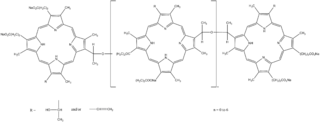Cytoluminescent Therapy is a proposed cancer treatment as a form of Photodynamic Therapy (PDT) characterized by a photosensitiser that is supposedly eliminated from normal tissue but selectively accumulated in neoplastic and dysplastic tissue. This is followed by whole body irradiation with light of the specific wave length which activates the photosensitiser. The result is supposed to be selective damage or elimination of tumor cells while normal tissues are unharmed. However, tests as of 2003 did not show any positive clinical effects in a group of 48 patients treated in this way.

Photodynamic therapy (PDT), is a form of phototherapy involving light and a photosensitizing chemical substance, used in conjunction with molecular oxygen to elicit cell death (phototoxicity).

δ-Aminolevulinic acid, an endogenous non-proteinogenic amino acid, is the first compound in the porphyrin synthesis pathway, the pathway that leads to heme in mammals, as well as chlorophyll in plants.
PUVA is an ultraviolet light therapy treatment for skin diseases: Eczema, Psoriasis, Graft-versus-host disease, Vitiligo, Mycosis Fungoides, Large Plaque Parapsoriasis and cutaneous T-cell lymphoma using the sensitizing effects of the drug Psoralen. The psoralen is applied or taken orally to sensitize the skin, then the skin is exposed to UVA.

Photosensitizers produce a physicochemical change in a neighboring molecule by either donating an electron to the substrate or by abstracting a hydrogen atom from the substrate. At the end of this process, the photosensitizer eventually returns to its ground state, where it remains chemically intact until the photosensitizer absorbs more light. This means that the photosensitizer remains unchanged before and after the energetic exchange, much like heterogeneous photocatalysis. One branch of chemistry which frequently utilizes photosensitizers is polymer chemistry, using photosensitizers in reactions such as photopolymerization, photocrosslinking, and photodegradation. Photosensitizers are also used to generate prolonged excited electronic states in organic molecules with uses in photocatalysis, photon upconversion and photodynamic therapy. Generally, photosensitizers absorb electromagnetic radiation consisting of infrared radiation, visible light radiation, and ultraviolet radiation and transfer absorbed energy into neighboring molecules. This absorption of light is made possible by photosensitizers' large de-localized π-systems, which lowers the energy of HOMO and LUMO orbitals to promote photoexcitation. While many photosensitizers are organic or organometallic compounds, there are also examples of using semiconductor quantum dots as photosensitizers.
Photomedicine is an interdisciplinary branch of medicine that involves the study and application of light with respect to health and disease. Photomedicine may be related to the practice of various fields of medicine including dermatology, surgery, interventional radiology, optical diagnostics, cardiology, circadian rhythm sleep disorders and oncology.

Porfimer sodium, sold as Photofrin, is a photosensitizer used in photodynamic therapy and radiation therapy and for palliative treatment of obstructing endobronchial non-small cell lung carcinoma and obstructing esophageal cancer.

Methyl aminolevulinate (MAL) is a drug used as a sensitizer in photodynamic therapy. It is a prodrug that is metabolized to protoporphyrin IX. It is marketed as Metvix.

Temoporfin (INN) is a photosensitizer used in photodynamic therapy for the treatment of squamous cell carcinoma of the head and neck . It is marketed in the European Union under the brand name Foscan. The U.S. Food and Drug Administration (FDA) declined to approve Foscan in 2000. The EU approved its use in June 2001.

Talaporfin is a chlorin based photosensitizer used in photodynamic therapy (PDT).
Photorejuvenation is a skin treatment that uses lasers, intense pulsed light, or photodynamic therapy to treat skin conditions and remove effects of photoaging such as wrinkles, spots, and textures. The process induces controlled wounds to the skin. This prompts the skin to heal itself, by creating new cells. This process—to a certain extent—removes the signs of photoaging. The technique was invented by Thomas L Roberts, III using CO2 lasers in the 1990s. Observed complications have included scarring, hyperpigmentation, acne, and herpes.

Motexafin lutetium is a texaphyrin, marketed as Antrin by Pharmacyclics Inc.
Photosens is a mixture of sulfonated aluminium phthalocyanines with various degrees of sulfonation. Developed in Russia.

Hematoporphyrin is a porphyrin prepared from hemin. It is a derivative of protoporphyrin IX, where the two vinyl groups have been hydrated. It is a deeply colored solid that is usually encountered as a solution. Its chemical structure was determined in 1900.

A photooxygenation is a light-induced oxidation reaction in which molecular oxygen is incorporated into the product(s). Initial research interest in photooxygenation reactions arose from Oscar Raab's observations in 1900 that the combination of light, oxygen and photosensitizers is highly toxic to cells. Early studies of photooxygenation focused on oxidative damage to DNA and amino acids, but recent research has led to the application of photooxygenation in organic synthesis and photodynamic therapy.
Photoimmunotherapy (PIT) is an oncological treatment that combines photodynamic therapy of tumor with immunotherapy treatment. Combining photodynamic therapy with immunotherapy enhances the immunostimulating response and has synergistic effects for metastatic cancer treatment.

Periowave is an antimicrobial photodynamic therapy (a-PDT) machine. It is used in periodontics, endodontics and operative dentistry to kill bacteria or inhibit the growth of bacteria. Antimicrobial photodynamic therapy is the process in which light and photosensitizer are used to destroy cell membrance of the bacteria by the action of reactive oxygen species and singlet oxygen. Professor Michael Wilson of University College London is the pioneer of photodisinfection or a-PDT which is a non-invasive, non-antibiotic and non-surgical procedure. The Periowave aPDT system was introduced to the market by Ondine Biomedical Inc., Vancouver B.C. in 2006. Periowave is approved for the treatment of chronic periodontitis, gingivitis, endodontics, and peri-implantitis disease.
Lasers are used to treat cancer in several different ways. Their high-intensity light can be used to shrink or destroy tumors or precancerous growths. Lasers are most commonly used to treat superficial cancers such as basal-cell skin cancer and the very early stages of some cancers, such as cervical, penile, vaginal, vulvar, and non-small cell lung cancer.
Tayyaba Hasan is a Professor of Dermatology at the Wellman Center for Photomedicine at Harvard Medical School. She is one of the inventors of Visudyne, a Food and Drug Administration approved treatment for age-related macular degeneration. She received the 2018 SPIE Britton Chance Biomedical Optics Award.











